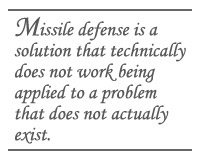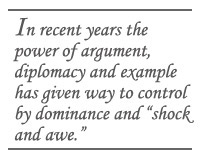US Pushes Pie-in-the-Sky Missile Defense in Europe
US Pushes Pie-in-the-Sky Missile Defense in Europe

LEEDS, UK, and ANTWERP: Missile defense will figure high on the agenda at the NATO summit of heads of state in Bucharest. The odds are that, without any meaningful parliamentary debate within or between European states, Europe will quietly go along with the US proposal to install missile-defense interceptors in Poland and a powerful radar system in the Czech Republic.
It also appears that further steps will then be taken to integrate this strategic US National Missile Defense system with Theater Missile Defense, currently being developed by NATO countries at an annual cost of €1 billion.
So, what's the problem with protecting European territory from the threat of nuclear-missile attack? Well, to start with, it is a solution that technically does not work being applied to a problem that does not actually exist. The current generation of missile interceptors is just not capable of intercepting long-range missiles. The deployment of a large number of decoy warheads in the missile can easily overwhelm the limited number of interceptors available. Some tests have succeeded in the past because the target missile carried a homing device that guided the interceptor and it was known when and where the target missile would be launched, in what direction and at what speed.

Would a real-world enemy announce in advance when an attack will take place, with what kind of rocket and which ballistic track – never mind have the decency to include a homing device in the warhead? The failure of the US and Israel to knock out the crude Iraqi Scud missiles in 1991 does not inspire hopes of the effectiveness of strategic missile defense.
The United States legitimizes this project by referring to the threat from Iran. However, the International Atomic Energy Agency (IAEA) visits the country on regularly and has not confirmed that Iran is working on a nuclear-weapons program. The United Nations Security Council has voted on four resolutions demanding that Iran halt its program to enrich uranium. In principle, the Treaty on the Non-Proliferation of Nuclear Weapons allows such a program. But because Iran did not declare, as required, its activities to the IAEA in the past, there’s strong suspicion that Iran’s effort was linked to a weapon program.
The US suggested that Iraq had a secret program to develop weapons of mass destruction before invading in March 2003, an assessment that turned out to be wrong. The most recent US National Intelligence Estimate in December 2007 claimed that Iran probably halted its nuclear-weapons program back in 2003. Even if Iran is still operating a secret nuclear-weapons program, the technological hurdles of fitting a long-range missile – which it does not currently possess – with a nuclear warhead are simply too overwhelming for a state that cannot smoothly and continuously operate thousands of centrifuges.

Even in the unlikely event that Iran is capable of producing the imagined threat, why would Iran decide to launch such a missile knowing that it would be answered by a similar or probably much larger counterattack? If Iran really wanted to attack the West, there are better means available, including an anonymous nuclear terrorist attack by truck, ship or small aircraft. No missile-defense system could prevent the most logical means of attack. At most, missile defense creates a false sense of security.
If Iran poses a threat of a missile-launched nuclear attack, then the interceptors should be stationed in Turkey, not in Eastern Europe. The choice of the latter is, of course, causing Russia concern. Russians respond as if convinced that the US is targeting their silos and not those of Iran.
The Pentagon denies targeting Russia, stating that the interceptors could not catch missiles fired from Russian silos. However, calculations by Massachusetts Institute of Technology Professor Ted Postol indicate that the US military may have overestimated the velocity of Russian missiles and underestimated the velocity of US interceptors. Thus, the Russian claims may not be that outrageous. This, together with Russian fears that more interceptors will follow, leads to concerns about the strategic balance of nuclear weapons between the two major states.

It is not surprising therefore that President Vladimir Putin continuously criticizes these moves by the US. To demonstrate concern, Russia has refused to implement START II and recently suspended the Treaty on Conventional Armed Forces in Europe because of missile defense. If these missile-defense systems are installed in the foreseeable future, it’s likely that Russia will take further retaliatory steps.
Such costs surely outweigh the nonexistent benefits. A new Cold War and accompanying arms race is in the making. Opponents will build more offensive missiles to circumvent new defensive systems and vice versa. Nobody will benefit from it, except major US defense firms like Boeing, Raytheon and Lockheed Martin.
A few years ago there was a similar discussion in the US when the development of National Missile Defense was criticized for disturbing the strategic nuclear balance – possibly allowing a dominant side to execute a nuclear first strike without fear of retaliation. On the other hand, no one was speaking out against Theater Missile Defense, because few could find fault with nations protecting their troops in the field.
However, the military industrial complex was determined to get billions of dollars spent on missile defense – so it came up with the idea of combining the two into what became known as “layered missile defense.” This is the current approach and combines two defense systems – national missile and theater missile – to target ballistic missiles at the launch, mid-course and terminal stages of trajectory. It appears that the same strategy is being applied in Europe.
Why do Poland and the Czech Republic agree? The US promises these countries big contracts and help to modernize their aging military infrastructure. The Polish and Czech population is not in favor – polls indicate that up to 70 percent oppose such plans. But the Poles and Czechs have as much to say as did the people in Western Europe in the early 1980s with respect to the installation of the Euro-missiles.
As the threat environment does not allow the US to build more offensive weapons, the defense industry seeks a substitute activity, and technological optimism also comes into play.

Siting non-missiles in Europe can be seen as part of the development of US strategic thinking from “pre-emption” to “prevention,” a move from “deterrence” to “denial.” Missile defense is the defensive component of the New Triad described in the 2002 Nuclear Posture Review. The triad also involves nuclear and non-nuclear offensive components including another Pentagon dream – to field by 2020 a fully operational Prompt Global Strike system that will provide the capability of striking targets anywhere on Earth within 60 minutes.
These dream solutions to international situations may or may not be technically feasible, but they’re certainly costly. Apart from the escalating financial implications now regarded as unsustainable, there are significant costs to the US reputation. In recent years the power of argument, diplomacy and example has given way to control by dominance and “shock and awe.”
Thus, while the US economy slips into recession, the Bush administration continues to spend $10 billion dollars every year on pie in the sky. It’s not in Europe’s interest to go along in co-financing this unreliable, unnecessary and threat-provoking system.
Tom Sauer is assistant professor in international politics at the University of Antwerp in Belgium; Dave Webb is professor in engineering and director of the Praxis Centre at Leeds Metropolitan University in the United Kingdom.